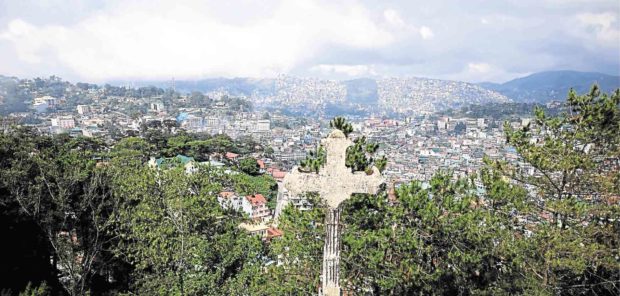Baguio City groans from too many visitors

Credit to Author: besguerra| Date: Sun, 17 Feb 2019 23:23:10 +0000
BAGUIO CITY — Urban decay comes to mind every time city residents count the hours before water comes out of their faucets, or when walking is a faster option to get to downtown so they won’t be late for classes.
A draft report of an urban carrying-capacity study commissioned by the National Economic and Development Authority (Neda) has found that the city’s resources are hardly enough for its population. Findings of the study were presented here on Feb. 15.
Baguio’s water supply, roads, urban facilities and public services are sufficient by the thinnest of margins for its population of 345,366 (2015 census) but are woefully inadequate for its daytime population, especially when hordes of tourists come to visit in summer or the Christmas season, according to the study team from consultancy group Certeza Infosys.
‘Daylight population’
But these resources are further strained by a “daylight population” composed of transient students, employees from other towns and provinces, and out-of-town entrepreneurs who transact business in Baguio, Certeza economist Gladys Navarro said.
According to the study, Baguio has not yet breached its carrying capacity — the population ceiling set by economists before a community’s resources are no longer enough for everyone.
It will exceed the capacity though when its population rises to 700,000, the study added.
Tourists
The daytime population on weekdays has grown to 725,366, doubling when tourists arrive during the Yuletide and summer months, according to Candido Cabrido, the project leader.
Baguio was designed and built by the American colonial government in 1909 for 25,000 people, but population spikes occurred in the 1970s and after the city was devastated by the 1990 Luzon earthquake, Navarro said.
After reconstruction, Baguio tried to draw back people following massive outmigration “but had overmarketed the city after 1990 through [attractions like] Panagbenga [the Baguio Flower Festival],” she said.
Migration, as well as the transient population, has replaced new births as the reason for Baguio’s current pace of population growth.
Transients leave the city at the conclusion of their transactions so they should not consume too much of the city resources, Cabrido said.
“But residents would naturally complain when they feel that tourists, or people living in boarding houses, are being prioritized,” Navarro said.
The study matched findings with public perception and validated concerns about overcrowding, pollution and resource scarcity.
Inadequate road network
The study confirmed that Baguio’s current road system spanning 349 kilometers “can only support 145,416 [residents].”
Narrow roads and the high volume of private and public vehicles have led to traffic jams, air pollution and the subsequent diminution of income for commuters “who spend more time traveling.”
The study also said the city’s solid waste management and sewerage systems had been inadequate.
The Certeza team used satellite images and maps and determined that forest cover was only 23 percent of the total area of the city.
“The population threshold of water supply is 267,546 [consumers], which is lower than the current population,” it said.
Water rationing
Water has been rationed since the late 1980s, with each resident getting an average of 0.15 cubic meter a day.
High-rise buildings, 52 of them more than eight stories high, have been concentrated in heavily populated sections of the city, leading to overcrowding, the study said.
According to Cabrido, Baguio is ideal for low-density development because of its terrain, although new engineering technology could make buildings safer on the mountains.
At the Philippine Military Academy on Saturday, Environment Secretary Roy Cimatu said he might ask Malacañang to revoke Baguio’s exemption from Presidential Decree No. 705.
The Forestry Code of the Philippines prohibits the construction of houses and buildings on steep slopes.
Section 15 of the code states that “no land of the public domain 18 percent in slope or over shall be classified as alienable and disposable, nor any forest land 50 percent in slope or over, as grazing land.”